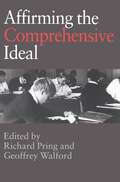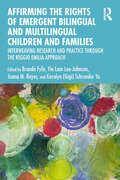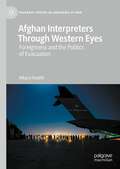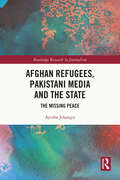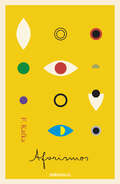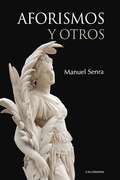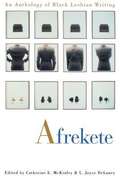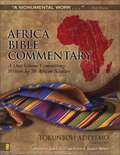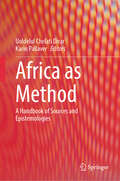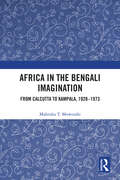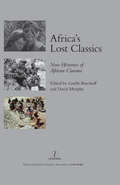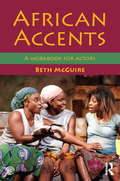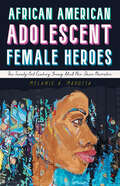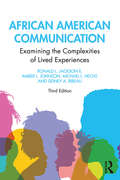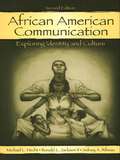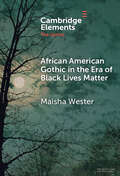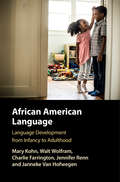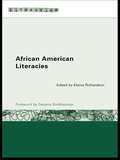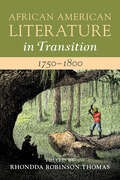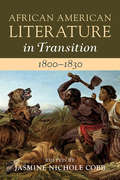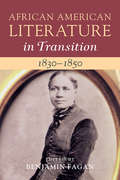- Table View
- List View
Affirming the Comprehensive Ideal
by Richard PringExamines the ideals which lay behind the development of comprehensive schools. Written by 14 British educationalists, this text considers the evidence and suggests how further progress might be made within the moral framework of secondary education for all, irrespective of background or ability. The text includes an afterword by the Rt Hon John Prescott, MP, Deputy Leader of the Labour Party.
Affirming the Rights of Emergent Bilingual and Multilingual Children and Families: Interweaving Research and Practice through the Reggio Emilia Approach
by Brenda Fyfe Yin Lam Lee-Johnson Juana M. Reyes Geralyn Gigi Schroeder YuAffirming the Rights of Emergent Bilingual and Multilingual Children and Families explores how the philosophy, principles, and practices of the internationally acclaimed Municipal Preschools and Infant Toddler Centers of Reggio Emilia, Italy, advance the social justice and linguistic human rights of emergent bilingual and multilingual children and their families, particularly immigrants and refugees. The book is driven by the authors’ research-based discourse including an interview with Reggio Emilia educators and direct observations in the Preschools and Infant–toddler Centers in Italy. Chapters include survey and follow-up interviews, and classroom examples from U.S. early childhood educators inspired by the Reggio Emilia approach some of whom are in multilingual settings. Recommendations are included for practitioners who are intentional about advocating for the rights of emergent bi- and multilingual young children. Also included are the researchers’ interpretations and reflexive narratives on contextuality, intersectionality, and intertextuality, which interweave theories and practice. The insightful examinations of scholarly work and the critical review of the distinctive features of the Reggio Emilia philosophy contribute to an early childhood education transformative lens that challenges the status quo of inequities and foregrounds the linguistic and cultural rights of learners who speak different languages. The authors review research and theory that inform the latest developments in culturally and linguistically responsive practices in innovative early education (infant through pre-k), family participation, and teacher preparation and development. Of general interest to educators and researchers around the world who work to ensure the rights of emergent language learners, this is an essential text for upper-level and graduate students, early childhood educators, educational and community leaders, administrators, and researchers.
Afghan Interpreters Through Western Eyes: Foreignness and the Politics of Evacuation (Palgrave Studies in Languages at War)
by Hilary FootittThis book explores how endangered local interpreters in Afghanistan were seen through Western eyes in the period from 2014, when the West drew down the bulk of its military forces, to the summer of 2021, when NATO forces withdrew completely. The author examines how these interpreters were understood and represented by Western governments, militaries, agencies, press and lobby organisations, how the understandings changed over time, and to what extent the representations reflect distinct rationales for intervention/historic relationships with Afghanistan, specific immigration and anti-terrorism policies, and notions of citizenship. The book will be of interest to students and scholars of translation and interpreting, history, war studies, and migration studies.
Afghan Refugees, Pakistani Media and the State: The Missing Peace (Routledge Research in Journalism)
by Ayesha JehangirDrawing on the frameworks of peace journalism, this book offers new insights into the Pakistani media coverage of Afghan refugees and their forced repatriation from Pakistan. Based on a three-year-study, the author examines the political, social and economic forces that influence and govern the reporting practices of journalists covering the protracted refugee conflict between Pakistan and Afghanistan. Through a critical discourse analysis of the structures of journalistic iterability of Afghan refugees in Pakistan, the author distils four dominant and three emerging frames, and proposes a new teleological turn for peace journalism as deliberative practice, that is to say practice that by promoting transparency and accountability (recognition) and challenging dominant power-proposed narratives and perspectives (resistance) encourages public engagement and participation (cosmopolitan solidarity). The author also privileges an analytical approach that conceptualises the nexus between digital witnessing and peace journalism through the paradigm of cosmopolitanism. The author finds routinely accommodated media narratives of security that represent Afghan refugees as a ‘threat’, a ‘burden’ and the ‘other’ that, through reinforcement, have become an incontestable reality for the public in Pakistan. This book will appeal to those interested in studying and practicing journalism as a conscientious communicative practice that elicits the very public it seeks to inform.
Aforismos
by Franz KafkaUna recopilación inédita que nos habla del hombre, de las dificultades del artista, de sus miedos más profundos y de la vigencia de sus lecciones. En los cuadernos en octavo y en los diarios de Franz Kafka existe una gran variedad de textos dispersos, pensamientos condensados que fueron designados por el mismo autor como aforismos o que han sido considerados como tales en las diferentes ediciones de la obra del autor y, sobre todo, en la edición crítica y canónica que la editorial S. Fischer viene publicando desde 1982 y que es la que recoge la biblioteca Kafka en DeBols!llo. Este volumen, editado por Ignacio Echevarría y Jordi Llovet, ofrece al lector un cuidado compendio de aforismos que incluye, además del «Legajo de los aforismos» (1918), una serie de textos espigados de los cuadernos y legajos póstumos (1916 a 1923) y de los diarios (1920-1921). Una recopilación inédita que nos habla del hombre, de las dificultades delartista, de sus miedos más profundos y de la vigencia de sus lecciones. Reseña:«Kafka comprendía que los viajes, el sexo y los libros son caminos que no llevan a ninguna parte, y que sin embargo son caminos por los que hay que internarse y perderse para volverse a encontrar o para encontrar algo.»Roberto Bolaño
Aforismos y otros
by Manuel SenraUna joya de libro para amantes de la palabra. Iniciamos la sinopsis con una disposición gráfica relacionada con los aforismos. Así como la presentación de otros términos, que funcionan de modo similar al aforismo. Y donde, entre otros, hallaríamos el adagio, el proverbio, la frase corta... Todos son pensamientos que expresan una sentencia, una enseñanza, una advertencia moral o una reflexión filosófica.
Afrekete: An Anthology of Black Lesbian Writing
by Catherine E. Mckinley Joyce DelaneyDestined to become a classic in the tradition of the best-selling Black-Eyed Susans/Midnight Birds and Erotique Noire/ Black Erotica. Afrekete gives collective voice to the tradition of black lesbian writing. In the vast and proliferating area of both African-American and lesbian and gay writing, the work of black lesbians is most often excluded or relegated to the margins. Afrekete meshes these seemingly disparate traditions and celebrates black lesbian experiences in all their variety and depth. Elegant, timely, provocative, and inspiring, the fiction, poetry, and nonfiction in Afrekete -- written in a range of styles -- engage a variety of highly topical themes, placing them at the center of literary and social discourse. Beginning with "Tar Beach," an excerpt from Audre Lorde's celebrated memoir Zami: A New Spelling of My Name, which introduces the character Afrekete, the collection also includes such prominent writers as Michelle Cliff, Carolivia Herron, Jewelle Gomez, and Alexis De Veaux. Other pieces are by Jacqueline Woodson, Sapphire, Essence editor Linda Villarosa, and filmmaker Michelle Parkerson, with other contributions by exciting new writers Cynthia Bond, Jocelyn Taylor, Jamika Ajalon, and Sharee Nash. Afrekete is a collection whose time has come. It is an extraordinary work, one of lasting value for all lovers of literature. A fresh, engaging journey, Afrekete will both inform and delight.
Africa Bible Commentary: A One-Volume Commentary Written by 70 African Scholars
by ZondervanThe Africa Bible Commentary is a unique publishing event—the first one-volume Bible commentary produced in Africa by African theologians to meet the needs of African pastors, students, and lay leaders. Interpreting and applying the Bible in the light of African culture and realities, it furnishes powerful and relevant insights into the biblical text that transcend Africa in their significance. The Africa Bible Commentary gives a section-by-section interpretation that provides a contextual, readable, affordable, and immensely useful guide to the entire Bible. Readers around the world will benefit from and appreciate the commentary’s fresh insights and direct style that engage both heart and mind. Key features: · Produced by African biblical scholars, in Africa, for Africa—and for the world · Section-by-section interpretive commentary and application · More than 70 special articles dealing with topics of key importance in to ministry in Africa today, but that have global implications · 70 African contributors from both English- and French-speaking countries · Transcends the African context with insights into the biblical text and the Christian faith for readers worldwide
Africa as Method: A Handbook of Sources and Epistemologies
by Karin Pallaver Uoldelul Chelati DirarThis methods handbook investigates the multiple sources and interdisciplinary methodologies employed by scholars working on Africa. It illuminates how scholars of Africa locate, select, interpret, and combine sources to reconstruct Africa’s past. Each contributor presents a specific typology of source or body of sources. Focusing on specific case studies, the chapters offer a broad overview of the methods and sources employed by historians, anthropologists, linguists, and related disciplines in the humanities and social sciences, working on Africa. The topics covered are diverse and include the significance of oral sources and how they relate to written sources; the perspectives provided by female writings on and from Africa; the relevance of Islamic court records for the study of Africa; the use of songs and poetry for the understanding of contemporary political protests; the employment of photographs and other visual sources for the study of the African past; how new sources or new interpretations of existing ones can provide different historical periodization; and finally, how biographies and autobiographies, including personal experiences with fieldwork in Africa, can contribute to shed light on Africa’s past. The book is a valuable resource for graduate students and academics interested in doing research on Africa. It provides a sweeping but rich understanding of the methodologies in the field of African studies, and for historians in general. Ultimately, this book contends that the specific methodologies developed for the study of Africa are relevant not only for the understanding of the continent itself, but can also contribute significantly to the historical method more widely.
Africa in Translation: A History of Colonial Linguistics in Germany and Beyond, 1814-1945
by Sara Pugach"Africa in Translationis a thoughtful contribution to the literature on colonialism and culture in Germany and will find readers in the fields of German history and German studies as well as appealing to audiences in the large and interdisciplinary fields of colonialism and postcolonialism. " ---Jennifer Jenkins, University of Toronto The study of African languages in Germany, or Afrikanistik, originated among Protestant missionaries in the early nineteenth century and was incorporated into German universities after Germany entered the "Scramble for Africa" and became a colonial power in the 1880s. Despite its long history, few know about the German literature on African languages or the prominence of Germans in the discipline of African philology. InAfrica in Translation: A History of Colonial Linguistics in Germany and Beyond, 1814--1945, Sara Pugach works to fill this gap, arguing that Afrikanistik was essential to the construction of racialist knowledge in Germany. While in other countries biological explanations of African difference were central to African studies, the German approach was essentially linguistic, linking language to culture and national identity. Pugach traces this linguistic focus back to the missionaries' belief that conversion could not occur unless the "Word" was allowed to touch a person's heart in his or her native language, as well as to the connection between German missionaries living in Africa and armchair linguists in places like Berlin and Hamburg. Over the years, this resulted in Afrikanistik scholars using language and culture rather than biology to categorize African ethnic and racial groups. Africa in Translationfollows the history of Afrikanistik from its roots in the missionaries' practical linguistic concerns to its development as an academic subject in both Germany and South Africa throughout the nineteenth and twentieth centuries. Sara Pugach is Assistant Professor of History at California State University, Los Angeles. Jacket image: Perthes, Justus. Mittel und Süd-Afrika. Map. Courtesy of the University of Michigan's Stephen S. Clark Library map collection.
Africa in the Bengali Imagination: From Calcutta to Kampala, 1928-1973
by Mahruba T. MowtushiThis book examines textual representations of Africa in the Indian imagination from 1928 to 1973. It critically analyses Bengali literature during this period, their imitation of colonial racial prejudices and how it allowed Bengalis to fashion their identity. It analyses the development of ‘Africa’ as an idea and historical reality through the writings of five Bengali writers including the Bengali novelist Bibhutibhushan Bandyopadhyay, the children’s author Hemendra Kumar Roy, the poet and philosopher Rabindranath Tagore, the playwright Ganesh Bagchi and the surrealist poet and founding editor of Transition magazine Rajat Neogy. The book shows how these writers engage with the idea of Africa and their influence in the construction of the Bengali cultural identity during the freedom struggle, the Partition of Bengal in 1947 and the creation of Bangladesh in 1971. The book offers readers a glimpse of the exotic imaginary locales of Africa while offering an in-depth look into the interconnected histories, cartographic routes and cultural exchange between India and Africa. A first of its kind, this book will be an excellent read for students and scholars of literature, comparative literature, history, cultural studies, postcolonial studies, South Asian studies, African studies and diaspora studies. .
Africa's Lost Classics: New Histories of African Cinema
by Lizelle BisschoffUntil recently, the story of African film was marked by a series of truncated histories: many outstanding films from earlier decades were virtually inaccessible and thus often excluded from critical accounts. However, various conservation projects since the turn of the century have now begun to make many of these films available to critics and audiences in a way that was unimaginable just a decade ago. In this accessible and lively collection of essays, Lizelle Bisschoff and David Murphy draw together the best scholarship on the diverse and fragmented strands of African film history. Their volume recovers over 30 'lost' African classic films from 1920-2010 in order to provide a more complex genealogy and begin to trace new histories of African filmmaking: from 1920s Egyptian melodramas through lost gems from apartheid South Africa to neglected works by great Francophone directors, the full diversity of African cinema will be revealed.
African Accents: A Workbook for Actors
by Beth McGuireThis is a comprehensive workbook for actors, covering the key characteristics and profiles of a wide range of African accents of English. Its unique approach not only addresses the methods and processes by which to go about learning an accent, but also looks in detail at each example. This lets the reader plot their own route through the learning process and tailor not only their working methods but also their own personal idiolect. Full breakdowns of each accent cover: an introduction giving a brief history of the accent, its ethnic background, and its language of origin preparatory warm-up exercises specific to each accent a directory of research materials including documentaries, plays, films and online resources key characteristics such as melody, stress, pace and pitch descriptions of physical articulation in the tongue, lips, jaw, palate and pharynx practice sentences, phoneme tables and worksheets for solo study. African Accents is accompanied by a website at www.routledge.com/cw/mcguire with an extensive online database of audio samples for each accent. The book and audio resources guide actors to develop their own authentic accents, rather than simply to mimic native speakers. This process allows the actor to personalize an accent, and to integrate it into the creation of character rather than to play the accent on top of character.
African American Adolescent Female Heroes: The Twenty-First-Century Young Adult Neo-Slave Narrative (Children's Literature Association Series)
by Melanie A. MarottaIn the wake of the second wave of the Black Lives Matter movement, inequalities and disparities were brought to light across the publishing industry. The need for more diverse, representative young adult literature gained new traction, resulting in an influx of young adult speculative fiction featuring African American young women. While the #BlackGirlMagic movement inspired a wave of positive African American female heroes in young adult fiction, it is still important to acknowledge the history and legacy of enslavement in America and their impact on literature. Many of the depictions of young Black women in contemporary speculative fiction still rely on stereotypical representations rooted in American enslavement.African American Adolescent Female Heroes: The Twenty-First-Century Young Adult Neo-Slave Narrative investigates the application of the neo-slave narrative structure to the twenty-first-century young adult text. Author Melanie A. Marotta examines texts featuring a female, adolescent protagonist of color, including Orleans, Tankborn, The Book of Phoenix, Binti, and The Black God’s Drums, as well as series like the Devil’s Wake series, Octavia E. Butler’s Parable series, and the Dread Nation series. Taken together, these chapters seek to analyze whether the roles for adolescent female characters of color are changing or whether they remain re-creations of traditional slave narrative roles. Further, the chapters explore if trauma, healing, and activism are enacted in this genre.
African American Communication: Examining the Complexities of Lived Experiences (Routledge Communication Series #Vol. 2)
by Michael L. Hecht Sidney A. Ribeau Ronald L. Jackson II Amber L. JohnsonNow in its third edition, this text examines how African Americans personally and culturally define themselves and how that definition informs their communication habits, practices, and norms. This edition includes new chapters that highlight discussions of gender and sexuality, intersectional differences, contemporary social movements, and digital and mediated communication. The book is ideally suited for advanced students and scholars in intercultural communication, interpersonal communication, communication theory, African American/Black studies, gender studies, and family studies.
African American Communication: Exploring Identity and Culture
by Michael L. Hecht Ronald L. Jackson Sidney A. RibeauWhat communicative experiences are particular to African Americans? How do many African Americans define themselves culturally? How do they perceive intracultural and intercultural communication? These questions are answered in this second edition of African American Communication: Exploring Identity and Culture. Informing multiple audiences interested in African American culture, from cultural researchers and practitioners to educators, policymakers, and community leaders, this innovative and invaluable resource examines the richness and depth of African American communication norms and patterns, as well as African American identities. Positive and healthy African American identities are centrally positioned throughout the book. Applying the cultural contracts theory and the communication theory of identity, authors Michael L. Hecht, Ronald L. Jackson II, and Sidney A. Ribeau explore relationships among African Americans, as well as between African Americans and European Americans, while highlighting the need for sensitivity to issues of power when discussing race, ethnicity, and culture. This wide-ranging volume provides an extensive review of the relevant literature and offers recommendations designed to encourage understanding of African American communication in a context extending beyond Eurocentric paradigms. Considering African American identity with a communicative, linguistic, and relational focus, this volume: *Defines African American identities by describing related terms, such as self, self-concept, personhood and identity; *Explores Afrocentricity and African American discourse; *Examines the status of African Americans in the United States using census statistics and national studies from other research agencies; *Considers identity negotiation and competence; and *Features a full chapter on African American relationships, including gendered, familial, intimate, adolescent and adult, homosexual, friendship, communal, and workplace relationships. African American Communication: Exploring Identity and Culture begins an important dialogue in the communication discipline, intercultural studies, African American studies and other fields concerned with the centrality of culture and communication as it relates to human behavior. It is intended for advanced students and scholars in intercultural communication, interpersonal communication, communication theory, African American/Black studies, social psychology, sociolinguistics, education, and family studies.
African American English and the Achievement Gap: The Role of Dialectal Code Switching (Routledge Research in Education)
by Holly K. CraigMany African American children make use of African American English (AAE) in their everyday lives, and face academic barriers when introduced to Standard American English (SAE) in the classroom. Research has shown that students who can adapt and use SAE for academic purposes demonstrate significantly better test scores than their less adaptable peers. Accordingly, AAE use and its confirmed inverse relationship to reading achievement have been implicated in the Black-White Test Score Gap, thus becoming the focus of intense research and practical interest. This volume discusses dialectal code-switching from AAE to SAE and stresses the benefits and importance of African American students becoming bi-dialectal. It provides background theory and science supporting the most promising educational approach to date, Contrastive Analysis, a set of longstanding methods drawn from Second Language research and used effectively with students ranging from kindergarten through college. It offers a deeper knowledge of AAE use by students, the critical features of Contrastive Analysis, and detailed information about successful applications which teachers can apply in their own pedagogy.
African American Gothic
by Maisha L. WesterThis new critique of contemporary African-American fiction explores its intersections with and critiques of the Gothic genre. Wester reveals the myriad ways writers manipulate the genre to critique the gothic's traditional racial ideologies and the mechanisms that were appropriated and re-articulated as a useful vehicle for the enunciation of the peculiar terrors and complexities of black existence in America. Re-reading major African American literary texts such as Narrative of the Life of Frederick Douglass, Of One Blood, Cane, Invisible Man, and Corregidora African American Gothic investigates texts from each major era in African American Culture to show how the gothic has consistently circulated throughout the African American literary canon.
African American Gothic in the Era of Black Lives Matter (Elements in the Gothic)
by Maisha WesterThis Element explores twenty-first century Black Gothic literature and film as it responds to American anti-Blackness and as they illustrate a mode of Black Gothic fiction termed Black Lives Matter (BLM) Gothic. The various texts express frustration, rage, and sorrow over the failures of previous civil rights fights. Intended as an introduction to a complex mode, this Element explores the three central themes in BLM Gothic texts and defines the mode's pattern of tropes. The first section reviews the depictions of American anti-Blackness, and defines the mode's pattern of tropes reveal the necropolitical mechanisms at play in US systemic racism. The second section explores the ways the fictions 'make whiteness strange' in order to destabilize white normativity and shatter the power arising from such claims. The final section examines the costs of waging war against racial oppression and the power of embracing 'monstrosity'.
African American Language: Language development from Infancy to Adulthood (Language In Society Ser. #7)
by Walt Wolfram Mary Kohn Charlie Farrington Jennifer Renn Janneke Van HofwegenFrom birth to early adulthood, all aspects of a child's life undergo enormous development and change, and language is no exception. This book documents the results of a pioneering longitudinal linguistic survey, which followed a cohort of sixty-seven African American children over the first twenty years of life, to examine language development through childhood. It offers the first opportunity to hear what it sounds like to grow up linguistically for a cohort of African American speakers, and provides fascinating insights into key linguistics issues, such as how physical growth influences pronunciation, how social factors influence language change, and the extent to which individuals modify their language use over time. By providing a lens into some of the most foundational questions about coming of age in African American Language, this study has implications for a wide range of disciplines, from speech pathology and education, to research on language acquisition and sociolinguistics.
African American Literacies (Literacies)
by Elaine RichardsonAfrican-American Literacies is a personal, public and political exploration of the problems faced by student writers from the African-American Vernacular English (AAVE) culture.Drawing on personal experience, Elaine Richardson provides a compelling account of the language and literacy practices of African-American students. The book analyses the problems encountered by the teachers of AAVE speakers, and offers African American centred theories and pedagogical methods of addressing these problems. Richardson builds on recent research to argue that teachers need not only to recognise the value and importance of African-American culture, but also to use African-American English when teaching AAVE speakers standard English.African-American Literacies offers a holistic and culturally relevant approach to literacy education, and is essential reading for anyone with an interest in the literacy practices of African-American students.
African American Literary Theory
by Winston Napier"African American Literary Theory is an extraordinary gift to literary studies. It is necessary, authoritative and thorough. The timing of this book is superb!" -Karla F.C. Holloway, Duke University"The influence of African American literature can be attributed, in no small part, to the literary theorists gathered in this collection. This is a superb anthology that represents a diversity of voices and points of view, and a much needed historical retrospective of how African American literary theory has developed." -Marlon B. Ross, University of Michigan"A volume of great conceptual significance and originality in its focus on the development of African American literary theory." -Farah Jasmine Griffin, University of PennsylvaniaAfrican American Literary Theory: A Reader is the first volume to document the central texts and arguments in African American literary theory from the 1920s through the present. As the volume progresses chronologically from the rise of a black aesthetic criticism, through the Blacks Arts Movement, feminism, structuralism and poststructuralism, and the rise of queer theory, it focuses on the key arguments, themes, and debates in each period.By constantly bringing attention to the larger political and cultural issues at stake in the interpretation of literary texts, the critics gathered here have contributed mightily to the prominence and popularity of African American literature in this country and abroad. African American Literary Theory provides a unique historical analysis of how these thinkers have shaped literary theory, and literature at large, and will be a indispensable text for the study of African American intellectual culture.Contributors include Sandra Adell, Michael Awkward, Houston A. Baker, Jr., Hazel V. Carby, Barbara Christian, W.E.B. DuBois, Ann duCille, Ralph Ellison, Henry Louis Gates, Jr., Addison Gayle Jr., Carolyn F. Gerald, Evelynn Hammonds, Phillip Brian Harper, Mae Gwendolyn Henderson, Stephen E. Henderson, Karla F.C. Holloway, Langston Hughes, Zora Neale Hurston, LeRoi Jones (Amiri Baraka), Joyce A. Joyce, Alain Locke, Wahneema Lubiano, Deborah E. McDowell, Harryette Mullen, Larry Neal, Charles I. Nero, Robert F. Reid-Pharr, Marlon B. Ross, George S. Schuyler, Barbara Smith, Valerie Smith, Hortense J. Spillers, Sherley Anne Williams, and Richard Wright.
African American Literature in Transition, 1750–1800: Volume 1 (African American Literature in Transition)
by Rhondda Robinson ThomasThis volume provides an illuminating exploration of the development of early African American literature from an African diasporic perspective—in Africa, England, and the Americas. It juxtaposes analyses of writings by familiar authors like Phillis Wheatley and Olaudah Equiano with those of lesser known or examined works by writers such as David Margrett and Isabel de Olvera to explore how issues including forced migration, enslavement, authorship, and racial identity influenced early Black literary production and how theoretical frameworks like Afrofuturism and intersectionality can enrich our understanding of texts produced in this period. Chapters grouped in four sections – Limits and Liberties of Early Black Print Culture, Black Writing and Revolution, Early African American Life in Literature, and Evolutions of Early Black Literature – examine how transitions coupled with conceptions of race, the impacts of revolution, and the effects of religion shaped the trajectory of authors' lives and the production of their literature.
African American Literature in Transition, 1800–1830: Volume 2, 1800–1830 (African American Literature in Transition)
by Jasmine Nichole CobbAfrican American literature in the years between 1800 and 1830 emerged from significant transitions in the cultural, technological, and political circulation of ideas. Transformations included increased numbers of Black organizations, shifts in the physical mobility of Black peoples, expanded circulation of abolitionist and Black newsprint as well as greater production of Black authored texts and images. The perpetuation of slavery in the early American republic meant that many people of African descent conveyed experiences of bondage or promoted abolition in complex ways, relying on a diverse array of print and illustrative forms. Accordingly, this volume takes a thematic approach to African American literature from 1800 to 1830, exploring Black organizational life before 1830, movement and mobility in African American literature, and print culture in circulation, illustration, and the narrative form.
African American Literature in Transition, 1830–1850: Volume 3 (African American Literature in Transition)
by Benjamin FaganThis volume charts the ways in which African American literature fosters transitions between material cultures and contexts from 1830 to 1850, and showcases work that explores how African American literature and lived experiences shaped one another. Chapters focus on the interplay between pivotal political and social events, including emancipation in the West Indies, the Irish Famine, and the Fugitive Slave Act, and key African American cultural productions, such as the poetry of Frances Ellen Watkins Harper, the writings of David Walker, and the genre of the Slave Narrative. Chapters also examine the relationship between African American literature and a variety of institutions including, the press, and the post office. The chapters are grouped together in three sections, each of which is focused on transitions within a particular geographic scale: the local, the national, and the transnational. Taken together, they offer a crucial account of how African Americans used the written word to respond to and drive the events and institutions of the 1830s, 1840s, and beyond.
